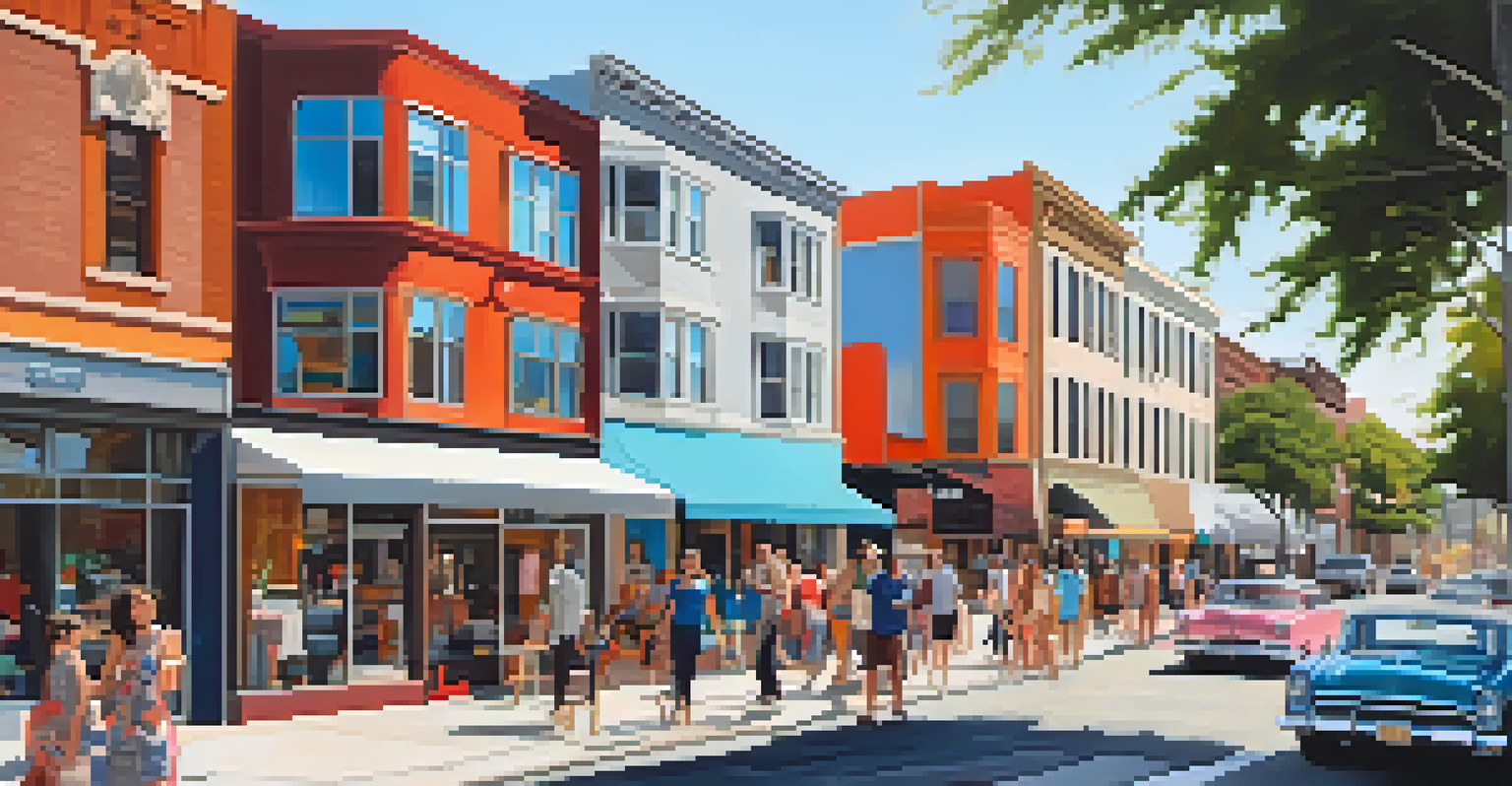Palm Springs' Historic Neighborhoods: A Journey Through Time

The Origins of Palm Springs: A Glimpse into History
Palm Springs began as a tranquil oasis for Native American tribes, particularly the Agua Caliente Band of Cahuilla Indians. The area’s warm climate and natural springs attracted visitors long before it became a resort destination. By the early 20th century, the town evolved, welcoming Hollywood celebrities seeking refuge from the hustle of city life.
Architecture is the art of how to waste space.
As these stars settled into the area, they brought a unique blend of glamour and creativity, leading to the development of iconic architecture. This period saw the rise of mid-century modern homes, which reflected the innovative spirit of the time. Today, these designs are celebrated as a defining feature of Palm Springs’ aesthetic.
Understanding the origins of Palm Springs helps us appreciate the historical significance of its neighborhoods. The stories of early inhabitants and famous residents intertwine, creating a rich tapestry of culture that continues to influence the city today.
Mid-Century Modern Architecture: A Design Legacy
Palm Springs is renowned for its mid-century modern architecture, which emerged in the 1940s and 50s. This style is characterized by clean lines, large windows, and a seamless connection between indoor and outdoor spaces. Walking through neighborhoods like Vista Las Palmas, you’ll feel as if you’ve stepped back into a glamorous era.

Many of these homes were designed by famous architects like Richard Neutra and Albert Frey, who aimed to blend modern living with the stunning desert landscape. The use of innovative materials, such as concrete and glass, allowed for a unique aesthetic that resonates with both visitors and residents. Tours of these iconic homes offer insights into the design philosophy that shaped the area.
Palm Springs' Rich Historical Roots
The origins of Palm Springs as a serene oasis for Native Americans and its evolution into a celebrity haven highlight its significant cultural history.
The legacy of mid-century modern architecture not only defines Palm Springs but also serves as a visual reminder of a transformative period in American design. It attracts architecture enthusiasts and casual visitors alike, making it a key part of the city’s identity.
The Historic Tennis Club District: A Social Hub
The Tennis Club District is one of Palm Springs’ oldest neighborhoods, dating back to the 1920s. Originally a playground for the elite, it attracted many famous personalities, including Frank Sinatra and Bing Crosby. This area is still vibrant today, with charming streets that invite exploration.
The best way to predict the future is to create it.
As you stroll through the Tennis Club, you can admire the beautifully preserved homes and lush landscaping that reflect the area’s historic charm. The district offers a blend of old and new, featuring boutique shops, art galleries, and trendy cafes. It’s a perfect spot for both history lovers and those looking to soak up the local culture.
This neighborhood stands as a testament to Palm Springs’ rich social history, where leisure and luxury intersect. The stories of past residents linger in the air, making it an essential stop for anyone looking to understand the city’s unique heritage.
El Mirador: A Glimpse of Glamour and Elegance
El Mirador, once a luxurious hotel and retreat, epitomizes the glamour of Palm Springs in the mid-20th century. Designed by the famous architect Paul Williams, this neighborhood was home to numerous celebrities who sought both relaxation and excitement. Today, the area retains its elegance while welcoming a new generation of residents and visitors.
The architecture of El Mirador showcases the distinctive style of the era, with its sprawling estates and lush gardens. These homes often feature stunning mountain views and are set against the dramatic backdrop of the San Jacinto Mountains. The neighborhood's history is palpable, as each structure tells a story of the glitz and glamour that once defined it.
Mid-Century Modern Architecture
Renowned for its mid-century modern architecture, Palm Springs showcases a design legacy that harmonizes innovative living with the stunning desert landscape.
Exploring El Mirador offers a unique opportunity to step back in time and experience the luxury lifestyle that was once reserved for the elite. Its blend of history and beauty makes it a must-see for anyone interested in Palm Springs’ storied past.
Historic Racquet Club Estates: Where Sports and Style Meet
Racquet Club Estates is another iconic neighborhood that became popular in the 1960s, known for its luxurious homes and tennis courts. This area was the first to offer private tennis courts in Palm Springs, attracting athletic celebrities like Dinah Shore and Sammy Davis Jr. The blend of sport and luxury made it a favorite among the elite.
The homes here exemplify mid-century modern design, featuring open layouts and seamless transitions to outdoor spaces. The lush landscaping and community spirit fostered a sense of belonging among residents. Today, many of these homes are preserved as historical landmarks, showcasing their importance in the city’s development.
Visiting Racquet Club Estates is an invitation to experience the fusion of leisure and lifestyle that defines Palm Springs. It’s a prime example of how sports and social culture have shaped the neighborhood's identity over the years.
The Uptown Design District: A Modern Renaissance
The Uptown Design District is a vibrant fusion of art, culture, and history, showcasing Palm Springs’ contemporary evolution. This area has become a hotspot for design enthusiasts, featuring chic boutiques, galleries, and trendy restaurants. It’s an exciting place where the old meets the new, reflecting the city’s dynamic spirit.
As you explore, you’ll find mid-century modern homes alongside innovative new builds that push architectural boundaries. The district’s commitment to design excellence is evident in every corner, making it a delightful destination for visitors. Many local events, such as the Palm Springs Modernism Week, celebrate this unique blend of history and modernity.
Preservation of Historic Neighborhoods
Efforts to preserve Palm Springs' historic neighborhoods are vital for maintaining the city's unique character and honoring its rich heritage.
The Uptown Design District encapsulates the ongoing transformation of Palm Springs, where creativity thrives and history is honored. It’s a testament to how neighborhoods can evolve while preserving their roots, making it a fascinating area to explore.
The Story of Old Las Palmas: A Celebrity Playground
Old Las Palmas is one of the most exclusive neighborhoods in Palm Springs, known for its luxurious homes and celebrity residents. With its palm-lined streets and stunning architecture, this area has attracted stars like Elizabeth Taylor and Liberace since the 1930s. The allure of Old Las Palmas lies in its blend of privacy and opulence.
Walking through this neighborhood, you’ll notice the impressive estates that reflect various architectural styles, from Spanish Revival to mid-century modern. Each home has its own story, often filled with tales of Hollywood glamour and extravagant parties. The lush gardens and serene ambiance create a picturesque setting that feels worlds away from the busy city.

Old Las Palmas serves as a reminder of Palm Springs’ golden age, where the rich and famous found solace in the desert. It remains a symbol of luxury and privacy, drawing visitors eager to experience the glitz of yesteryear.
Preserving History: The Importance of Historic Designation
As Palm Springs continues to grow, the preservation of its historic neighborhoods has become increasingly important. Local organizations and residents advocate for the protection of these areas to maintain their unique character and charm. The historic designation not only honors the past but also enhances the community’s identity.
Preserving these neighborhoods involves careful planning and collaboration between city officials and residents. This ensures that new developments respect the historical context while allowing for growth. Many neighborhoods host regular events to educate the community about their history, fostering a sense of pride and connection.
By prioritizing preservation, Palm Springs safeguards its rich heritage for future generations. It’s a crucial step in celebrating the city’s unique story while embracing the changes that come with modern living.